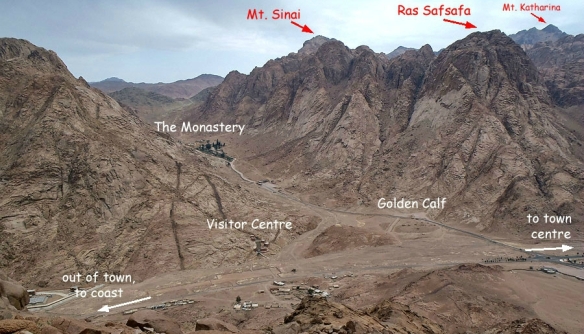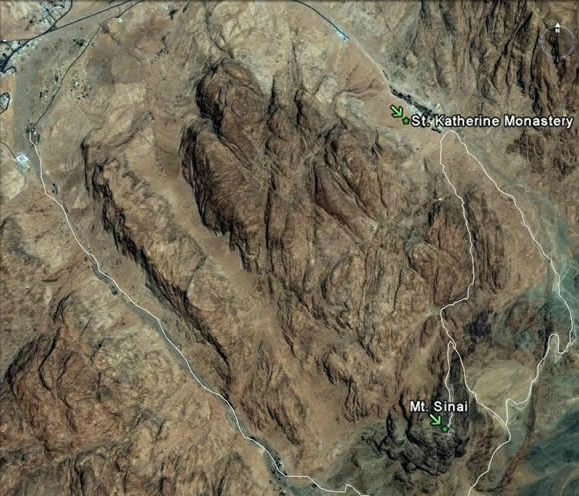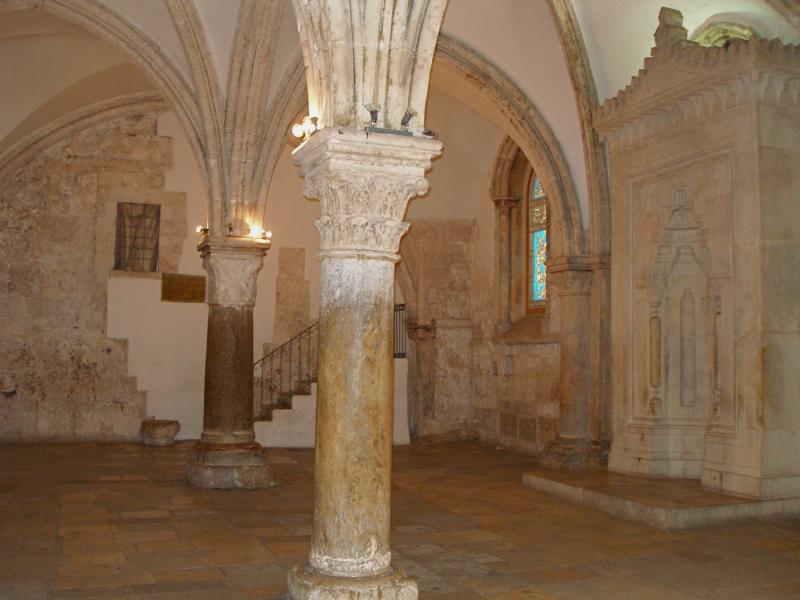Today’s readings are from Exodus 19; Luke 22; Job 37 and 2 Corinthians 7.
Exodus 19 is the preparation for the giving of the Mosaic covenant (Exodus 19:1-24:11). Israel is at Mount Sinai (Mt. Horeb). The Lord had liberated Israel from bondage in Egypt, but now He adopted the nation into a special relationship with Himself.
At Sinai, Israel received the Law and the tabernacle. The Law facilitated the obedience of God’s redeemed people, and the tabernacle facilitated their worship. Thus the Law and the tabernacle deal with the two major expressions of the faith of the people redeemed by the grace and power of God: obedience and worship.
The Mosaic Covenant is an outgrowth of the Abrahamic Covenant, in the sense that it was a significant, intimate agreement between God and Abraham’s descendants. By observing it, the Israelites could achieve their purpose as a nation. This purpose was to both experience God’s blessing, and to be a blessing to all the nations of the earth (Gen. 12:2). In contrast to the Abrahamic Covenant, Israel now had responsibilities to fulfill in order to obtain God’s promised blessings (v. 5). The Mosaic Covenant was, therefore, a conditional covenant. The Abrahamic Covenant—as well as the Davidic and New Covenants that contain expansions of the promises in the Abrahamic Covenant—was unconditional.
John Walvoord wrote:
“The major difference between the Mosaic covenant and the Abrahamic covenant is that the former was conditional and also was ad interim, that is, it was a covenant for a limited period, beginning with Moses and ending with Christ. . . .
“In contrast to the other covenants, the Mosaic covenant, though it had provisions for grace and forgiveness, nevertheless builds on the idea that obedience to God is necessary for blessing. While this to some extent is true in every dispensation, the Mosaic covenant was basically a works covenant rather than a grace covenant. The works principle, however, was limited to the matter of blessing in this life and was not related at all to the question of salvation for eternity.”
The Israelites arrived and “camped” at the base of (“in front of”) “the mountain,” where God would give them the Law, about three months after they had left Egypt, in May-June (v. 1). The mountain in the Sinai range, that most scholars have regarded as the mountain peak referred to in this chapter, stands in the southeastern part of the Sinai Peninsula (although this is disputed by some). Its name in Arabic is Jebel Musa, “Mountain of Moses.”




Dr. Curtis D. Ward
The nation stayed at Mt. Sinai 11 months (Num. 10:11). The record of their experiences here continues through Numbers 10:10.
Many reliable scholars have considered verses 3-6 to be the very heart of the Pentateuch, because they contain the classic expression of the nature and purpose of the theocratic covenant that God made with Israel, the Mosaic Covenant.
“The meaning of this covenant is expounded in the introductory verses of chapter 19: the covenant is an election, ‘you belong to me from among all peoples’; it is a bond, the people will have with Yahweh the particularly close bond of belonging which characterizes the priestly function; it is an obedience, for if Yahweh is king, the members of the people can only be the subjects who will follow him everywhere he leads (Ex. 15.18; Num. 23.21; Dt. 33.5; Jg. 8.23).”
God’s promise to Israel here (vv. 5-6) went beyond what He had promised Abraham. If Israel would be obedient to God, He would do three things for the nation (cf. Josh. 24:15):
- Israel would become God’s special treasure (“My own possession”; v. 5). This means that Israel would enjoy a unique relationship with God compared with all other nations. This was not due to any special goodness in Israel, but strictly to the sovereign choice of God.
- Israel would become a “kingdom of priests” (v. 6). This is the first occurrence in Scripture of the word “kingdom” as referring to God’s rule through men on earth.
“This is to be no ordinary kingdom where men will rule upon earth in their own right, but rather a kingdom ‘unto me,’ that is, unto Jehovah. In other words, whatever else its characteristics may be, it is to be, first of all, God’s kingdom.”
A priest stands between God and people. Israel could become a nation of “mediators” standing between God and the other nations, responsible for bringing them to God and God to them. Israel would not be a kingdom run by politicians, depending on strength and wit, but one of priests, depending on faith in Yahweh: a “servant nation” rather than a ruling nation.
- Israel would become “a holy nation” (v. 6). “Holy” means “set apart” and therefore “different.” The Israelites would become different from other peoples, because they would devote themselves to God, and separate from sin and defilement as they obeyed the law of God.
The reaction of Israel was understandably positive, and God approved it (Deut. 5:27-28). They wanted what God offered them. However, they seriously overestimated their own ability to keep the covenant, and they vastly underestimated God’s standards for them. This twin error is traceable to a failure to appreciate their own sinfulness and God’s holiness. The Mosaic Law would teach them to appreciate both more realistically (cf. Deut. 5:29).
God again (19:16-25) used the symbol of fire to reveal Himself on this mountain (3:2-5). Dr. Curtis Ward notes the difference in color on the top of Jebel Musa:

See the darker color of earth at the green arrow.
“…And the mountain burned with fire unto the midst of heaven, with darkness, clouds, and thick darkness.”
…….Deuteronomy 4:11
” And the LORD spake unto you out of the midst of the fire: ye heard the voice of the words, but saw no similitude; only ye heard a voice. And he declared unto you his covenant, which he commanded you to perform, even ten commandments; and he wrote them upon two tables of stone.”
……Deuteronomy 4:12-13
Comparative ancient Near Eastern studies have revealed that the covenant form and terminology that God used to communicate His agreement with Israel were common in Moses’ day. There were two basic types of formal covenants in the ancient Near East: parity (between equals) and suzerainty (between a sovereign and his subjects). The Mosaic Covenant was a suzerainty treaty. Such agreements characteristically contained a preamble (v. 3), historical prologue (v. 4), statement of general principles (v. 5a), consequences of obedience (vv. 5b-6a), and consequences of disobedience (omitted here).
God gave the Mosaic Law to the Israelites for several purposes:
- To reveal the holiness of God (1 Peter 1:15)
- To reveal the sinfulness of man (Gal. 3:19)
- To reveal the standard of holiness required of those in fellowship with God (Ps. 24:3-5)
- To supervise physical, mental, and spiritual development of redeemed Israelites until they should come to maturity in Christ (Gal. 3:24; Ps. 119:71-72)
- To be the unifying principle that made the establishment of the nation possible (Exod. 19:5-8; Deut. 5:27-28)
- To separate Israel from the nations in order to enable them to become a kingdom of priests (Exod. 19:5-6; 31:13)
- To make provision for forgiveness of sins and restoration to fellowship (Lev. 1—7)
- To make provision for a redeemed people to worship by observing and participating in the yearly festivals (Lev. 23)
- To provide a test that would determine whether one was in the kingdom (theocracy) over which God ruled (Deut. 28)
- To reveal Jesus Christ.
Tom Constable summarizes our relationship to the law:
The whole Mosaic Law, in all of its parts, was given to the nation of Israel, not to the church (cf. 19:3). Israel was a physical nation: with a homeland, a capital city (eventually), citizens composed of Jews and naturalized proselytes, and believers and nonbelievers. The church is a spiritual nation: with no homeland on this earth, no capital city on earth, citizens composed of Jews and Gentiles without distinction, and believers only.
What is the Christian’s relationship to the Mosaic Law? We are not under it (Rom. 10:4; 1 Cor. 9:20; Gal. 5:18; Heb. 7:12). It is not the code that regulates the behavior of believers today, though 9 of the Ten Commandments have been incorporated into (repeated in) the covenant under which we live, the exception being the fourth commandment. Are Christians under any code of laws, like the Israelites were? Yes. Paul referred to our code of laws as the Law of Christ (Gal. 6:2; 1 Cor. 9:21). Other names are the Law of Liberty (James 1:25; 2:12) and the New Covenant (2 Cor. 3:6; Heb. 8:8, 13; 12:24).
There are similarities and differences between the Law of Moses and the Law of Christ. They both contain positive and negative commands. Some of the commands in both are identical, but other commands appear in one code but not the other. Similarly, there are many of the same commands in English law as there are in American law. For example, it is illegal to commit murder under both codes of law. But there are also significantly different commands. For example, under English law it is illegal to drive on the right hand side of the road, but under American law it is illegal to drive on the left side. The empowerment of the Holy Spirit is not the only difference between the two covenants, as some Christians assume.
What value does the Mosaic Law have for Christians today? All Scripture is profitable (2 Tim. 3:16), and the Mosaic Law is part of Scripture. The Mosaic Code had two main purposes: regulatory and revelatory. Calvin called these their ceremonial and moral purposes. The Mosaic Law does not regulate or rule over the lives of Christians, as it did the lives of the Israelites (Gal. 4:8-11), but it does reveal much about God, man, and our relationship. Therefore we should read and study this portion of Scripture, even though we are not obligated to keep all of the commands (i.e., observe all its ceremonies).
We can tell which ones we are to keep by comparing the Law of Moses with the Law of Christ. The “Law of Christ” consists of all the teaching that Christ gave, both during His earthly ministry, and through His apostles and prophets after He went back to heaven (cf. Acts 1:1-2). Principles revealed in the Mosaic Law can help us to clarify our responsibilities as well. For example, we can learn what it means to “love our neighbor” by observing how God wanted the Israelites to treat non-Israelites.
Were the Israelites saved by keeping the Mosaic Law? No. They were saved by faith, not by works (Rom. 3:18-30).
Luke 22 begins the passion section in Luke’s gospel. It begins with the celebration of Passover and the Lord’s Supper (22:1-23). First, is the plot to arrest Jesus (22:1-2), in which Judas conspires, for thirty pieces of silver (22:3-6), then preparation for the Passover (22:7-13).
The Jews slew their Passover lamb on the fourteenth of Nisan and ate it after sundown. Sundown began the fifteenth. The fourteenth would have been Thursday until sundown. Verse 7 marks the transition to Thursday from Wednesday, the day on which Jesus had His controversy with the leaders in the temple and gave the Olivet Discourse.

This map represents the assumed location of the upper room. The salmon line represents Jesus leaving Bethany, but it should go into the temple mount instead of around it.

Israel Institute of Biblical Studies Blog
Of course, this is not the way it would have looked when Jesus and the disciples celebrated the Lord’s Supper there, nor is it definitely the location.

In vv. 14-18 Jesus celebrates the Passover meal with His disciples.
Jesus’ great desire (Gr. epithymia epethymesa, lit. “with desire I have desired,” v. 15 ) to eat this meal with the Twelve was due to the teaching that He would give them. It also arose from the fact that this would be His last fellowship meal with them. It was also the last “Passover” to be celebrated under the old Mosaic Covenant.
About vv. 17-18 and the drinking of the cup, Tom Constable explains:
There were four times that participants in the Passover meal drank together, commonly referred to as “four cups.” The Passover opened with a prayer of thanksgiving, followed by the drinking of the first cup. Then the celebrants ate the bitter herbs and sang Psalms 113—114. Next they drank the second cup and began eating the lamb and unleavened bread. Then they drank the third cup and sang Psalms 115—118. Finally they would drink the fourth cup. The “cup” in view in this verse may have been the first of the four. If it was, Jesus evidently did not participate in the drinking of the following three cups (v. 18).
The other Gospel writers did not refer to the first cup, so this may have been the third cup, the so-called “cup of redemption.” This view assumes that Jesus participated in the drinking of the first and second cups, which would have been normal. “From now on” or “again” (v. 18) could mean either “after this cup” or “after this Passover.” I favor the view that Jesus was referring to the “cup,” not the Passover, and that this was the third cup. Luke rearranged the order of events in the upper room considerably, as comparison with the other Gospels seems to indicate. Matthew and Mark have Jesus saying what Luke recorded in these verses—just after what Luke recorded in verse 20.
Jesus invested the common elements of unleavened bread and diluted wine with new significance. The “bread” represented His “body” given sacrificially for His disciples. The disciples were to eat it, as He did, symbolizing their appropriation of Him and their consequent union with Him. The “cup,” representing what was in it, symbolized the ratification of the “New Covenant” with Jesus’ “blood” (Jer. 31:31-34; cf. Exod. 24:8).
Luke placed Jesus’ announcement of His betrayal after the institution of the Lord’s Supper, whereas Matthew and Mark located it before that event in their Gospels. The effect of Luke’s placement is that the betrayal appears especially heinous in view of Jesus’ self-sacrifice for His disciples. The connecting link is the reference to Jesus’ death.
Whether Judas participated in the Lord’s Supper is unclear in Luke’s gospel. Matthew and Mark (also John 13:21-35) have him leaving before the Lord’s Supper, taking only the sop” which is associated with the Passover Meal. Since the Lord’s Supper is a memorial of Christ’s redemption for believers it would not seem appropriate for Judas to have shared in it.
Jesus then takes this opportunity to teach His disciples, for the last time (in John it’s called The Upper Room Discourse, John 13-17). He will touch on regular themes like humility (22:24-27) and rewards for faithfulness (22:28-30). He also predicts Peter’s denial and has that wonderful prayer…
31 “Simon, Simon, behold, Satan demanded to have you,that he might sift you like wheat, 32 but I have prayed for you that your faith may not fail. And when you have turned again, strengthen your brothers.”
Of course, Peter had confidence in himself (v. 33) but Jesus knew that needed to be put through the fire (1 Peter 1:6-7) so that what was really valuable–faith in Christ alone–would become more dominant.

The blue line represents the probable route back to Gethsemane.
Jesus predicted that opposition would arise (Luke 22:35-38) and this was promptly followed by His arrest (22:39-53). First, Jesus took His disciples to the Mount of Olives to pray (22:39-46). Here Jesus prays, struggling to take the “cup” of the wrath of God so much that he “sweat” drops of blood (22:44).
According to Debra Predow, this was the first of seven times Jesus shed His blood. I had never realized all the times Jesus shed His blood. Her applications may be a little stretched, but it is interesting.
Judas’ betrayal occurs in 22:47-53. Luke highlighted Judas’ hypocrisy in betraying Jesus “with a kiss,” the sign of friendship (cf. Gen. 27:26-27; 2 Sam. 15:5; 20:9; Prov. 7:13; 27:6), plus the fact that Jesus knew Judas’ purpose. Jesus prohibited His own disciples from striking back (22:49-50).
The trials of Jesus stretch throughout the night and next morning in Luke 22:54-23:25.
The following table (from Tom Constable) identifies the aspects of Jesus’ two trials that each evangelist recorded.
|
JESUS’ RELIGIOUS TRIAL |
||||
|
Matthew |
Mark | Luke |
John |
|
| Before Annas | 18:12-14, 19-24 | |||
| Before Caiaphas | 26:57-68 | 14:53-65 | 22:54, 63-65 | |
| Before the Sanhedrin | 27:1 | 15:1 | 22:66-71 | |
| JESUS’ CIVIL TRIAL | ||||
| Before Pilate | 27:2, 11-14 | 15:1-5 | 23:1-5 | 18:28-38 |
| Before Herod Antipas | 23:6-12 | |||
| Before Pilate | 27:15-26 | 15:6-15 | 23:13-25 | 18:39—19:16 |
While Jesus is being tried before Caiaphas, Peter denies Jesus three times (22:54-60). Immediately, a rooster crows. Luke alone records that “the Lord turned and looked at Peter (22:61). Luke’s unique reference to His turning and looking at Peter adds to the shock effect of the moment. The word that Luke used to describe Jesus’ looking usually means: to look with interest, love, or concern (Gr. emblepo). Peter suddenly “remembered” what Jesus had predicted earlier that evening (v. 34) and, undoubtedly, his profession of loyalty to Jesus (v. 33).
The realization of his unfaithfulness in this light, along with Jesus’ teaching on the importance of faithfulness, caused Peter to leave the courtyard and to weep tears of bitter remorse.
The mockery in vv. 63-65 likely happened during the trial before Caiaphas, while Peter was denying Him.
Following the informal interrogations by Annas and Caipahas, Jesus is brought before the Sanhedrin (the 70 member ruling council in religious matters) early on Friday morning. Harold Hoehner, who specialized in chronology, believes it it was April 3, 33 A.D.
Evidently the Sanhedrin members wanted to send Jesus on to Pilate for trial as early as they “lawfully” could. he Sanhedrin normally met in a building not far to the west of the western wall of the temple.
They asked if Jesus claimed to the the Messiah (22:67-68). He did claim to be “Son of Man,” which had Messianic implications (22:69-70) and they proclaimed that blasphemy (22:71), for He claimed to be equal to God.
The night, and the trials, are not over.
Job 37 is the finale of Elihu. Here Elihu continues to speak of God’s high descriptions of God. In verses 1-13 he cited more examples of God’s working in nature that we cannot comprehend fully (37:5).
We can learn that He does these things for different purposes. (37:7). Sometimes God does them for people’s benefit or harm, but sometimes He does them simply for the sake of His world (37:13).
At this point, Elihu turned again to apply these truths to Job’s situation (37:14-24). He urged Job to be humble before such a great God (37:14-20). Instead of dictating to God, Job should learn a lesson about the mystery of suffering from His wondrous acts in nature. No one can find God, but we can count on Him to be just (37:21-23). Job also needed to fear God (37:24)
In his four speeches, Elihu introduced a different reason for suffering: God has things to teach people that they can only learn through pain. He also described God in terms that suggest he may have had a more realistic, fuller concept of God than Job’s three friends did. All the same, neither Elihu nor the other three men had adequate insight into Job’s situation. They could not have had it unless God revealed to them what had transpired in His heavenly court (chs. 1—2).
Elihu’s words are closer to the truth and set the stage for God’s fuller special revelation of Himself that follows in chapters 38—42. Generally, Elihu emphasized the positive aspects of God’s character, whereas the other three comforters emphasized the negative aspects. Elihu saw God more as a teacher, whereas the other men spoke of Him as a judge.
2 Corinthians 7 continues the appeal to open their hearts to Paul and his authority, and stay away from “unequal yokes” with unbelievers. The final verse of chapter 16 spoke of the promise of an intimate relationship with God as Father, so 7:1 continues…
1 Since we have these promises, beloved, let us cleanse ourselves from every defilement of body and spirit, bringing holiness to completion in the fear of God.
Holiness is God’s purpose in saving us, as witnessed in these verses:
“For he chose us in him before the creation of the world to be holy and blameless in his sight.” (Ephesians 1:4)
“May he strengthen your hearts so that you will be blameless and holyin the presence of our God and Father when our Lord Jesus comes with all his holy ones.” (1 Thessalonians 3:13)
“For God did not call us to be impure, but to live a holy life.” (1 Thessalonians 4:7, in the context of immoral sexual behavior)
“Make every effort to live in peace with all men and to be holy; without holiness no one will see the Lord.” (Hebrews 12:14)
“As obedient children, do not conform to the evil desires you had when you lived in ignorance. 15 But just as he who called you is holy, so be holy in all you do; for it is written: ‘Be holy, because I am holy.'” (1 Peter 1:14-16)
Paul then repeats his appeal to the Corinthians (7:2). He was encouraged by their initial response (7:3-4). He then talks about his recent struggles (7:5) and his comfort through Titus (7:6-7).
In verses 8-10 he speaks of the “severe letter” he had sent and its results.
|
PAUL’S CORINTHIAN CONTACTS |
|||||||
| Paul’s founding visit | His “former letter” | The Corinthians’ letter to him | First Corinthians | Paul’s “painful visit” | His “severe letter” | Second Corinthians | Paul’s anticipated visit |
Paul admitted that he had regretted sending the severe “letter” after he had done so. He had subsequently thought that it was too harsh. Fortunately his readers responded to it as he had hoped they would, though it had “caused” them some pain (“sorrow”) at first. Fortunately it had not led the church into excessive discouragement but genuine “repentance.” The Corinthian believers had changed their thinking and their behavior.
The apostle then added a somewhat philosophical reflection on two possible responses to criticism and their consequences. The proper response, God’s will, results in a change of mind (“repentance”), which leads to deliverance from the bad situation (“salvation” in the temporal sense here), “without” later “regret.” The improper response, the world’s typical superficial response, does not result in a change of mind (repentance), but leads to resentment and bitterness (ultimately “death” in the temporal sense). Suffering in itself does not necessarily benefit us. It proves to be a good thing for us only as we respond to it properly (cf. James 1:2-4).

Paul identified several good things that had come to his Corinthian readers, because they had responded properly (with “godly sorrow”) to his recent rebuke. Their response had yielded “earnestness” (seriousness of purpose), the desire to prove themselves worthy (“what vindication of yourselves”), and righteous “indignation” at the affront to Paul. It had further resulted in: concern (godly “fear”) over their behavior and its effects, a “longing” to see Paul again, a determination (“zeal”) to make things right, and a correction of their error (“avenging of wrong”). The church had now put itself in the right, having been in the wrong: “you demonstrated yourselves to be innocent in the matter.”
Great article!!!
LikeLike